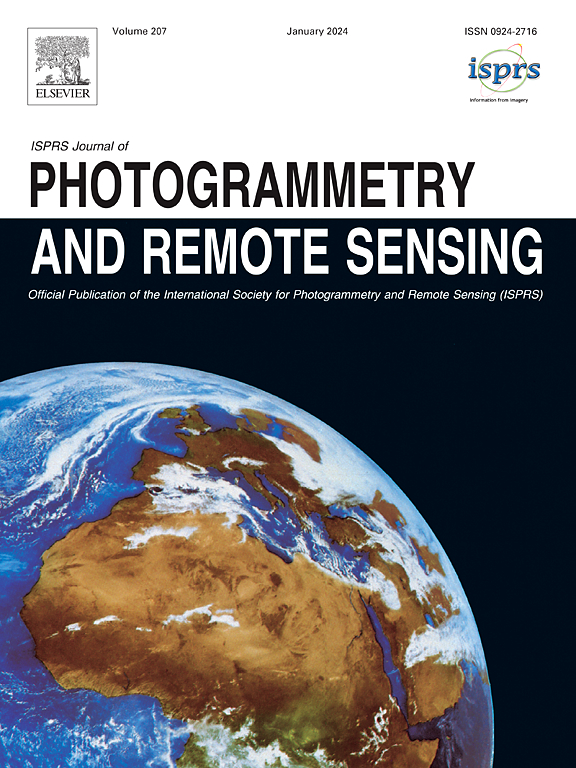A in-seasonal phenology monitoring approach for wheat breeding accessions with time-series RGB imagery by using a combination KNN-CNN-RF model
IF 12.2
1区 地球科学
Q1 GEOGRAPHY, PHYSICAL
ISPRS Journal of Photogrammetry and Remote Sensing
Pub Date : 2025-06-23
DOI:10.1016/j.isprsjprs.2025.06.015
引用次数: 0
Abstract
Accurate and near real-time monitoring of wheat phenology is crucial for both cultivation and breeding. It plays a pivotal role in guiding planting management, optimizing variety selection, enhancing yield and quality, and providing a scientific foundation for wheat production. This study aims to develop a high-throughput approach for identifying the real-time phenological stages and estimating the initiation date of key stages for abundant breeding accessions using UAV-derived RGB imagery. A two-year field experiment was conducted across diverse wheat accessions worldwide, including the Watkins landraces and modern varieties at different ecological locations in three provinces of Guangdong, Jiangsu, and Hebei. The minimalist neural network model VanillaNet was employed to classify the five phenological stages: tillering stage (TS), jointing and booting stage (JBS), heading stage (HS), anthesis and filling stage (AFS), and maturity stage (MS), based on image features. Meanwhile, the K-nearest neighbors algorithm categorized the phenological stage into three class—TS, JBS and heading to maturity stage (HMS)—using UAV-derived three-dimensional height data. To improve the classification accuracy, the weight coefficient was introduced to integrate the prediction probability of two classifiers. Finally, a random forest (RF) model was developed to estimate the initiation dates of key phenological stage based on the integrated time-series prediction probabilities. The results showed that the integrated classifier exhibited accuracies of 0.96, 0.88, 0.66, 0.87, and 0.96 in the five stages, respectively. Compared to the classification results obtained solely using neural network models, the increase in the F1-scores for the first three phenology stages was 7.41 %, 5.81 %, and 13.16 %, respectively. After stage classification, the RF model demonstrated robust performance in predicting the initiation dates of jointing, heading, anthesis, and maturity stages, with a coefficient of determination of 0.61–0.91 and a root mean square error of 1.83–4.09 days. Furthermore, the accuracy of phenological monitoring was analyzed under different data collection frequencies, revealing that the optimal interval for data collection was within 5–13 days. The proposed methodology realized synchronously the classification and quantification of phenological stages, thereby serving as a high-throughput screening technology of fine variety in smart wheat breeding.
基于KNN-CNN-RF组合模型的小麦育种资料季节物候监测方法
小麦物候的准确和近实时监测对栽培和育种都至关重要。它在指导种植管理、优化品种选择、提高产量和品质、为小麦生产提供科学依据等方面具有举足轻重的作用。本研究旨在开发一种高通量的方法来识别实时物候阶段,并利用无人机衍生的RGB图像估计大量繁殖物种的关键阶段的起始日期。在广东、江苏和河北三省不同的生态地点,对世界各地不同的小麦品种进行了为期两年的田间试验,包括沃特金斯地方品种和现代品种。采用极简神经网络模型VanillaNet,根据图像特征对水稻分蘖期(TS)、拔节孕穗期(JBS)、抽穗期(HS)、开花灌浆期(AFS)和成熟期(MS) 5个物候阶段进行分类。同时,k近邻算法利用无人机获取的三维高度数据,将物候阶段分为ts、JBS和走向成熟期(HMS)三个阶段。为了提高分类精度,引入权重系数对两个分类器的预测概率进行综合。最后,建立了基于时间序列综合预测概率的随机森林模型来估计关键物候期的起始日期。结果表明,综合分类器在5个阶段的准确率分别为0.96、0.88、0.66、0.87和0.96。与单独使用神经网络模型的分类结果相比,前3个物候期的f1评分分别提高了7.41%、5.81%和13.16%。经分期分类后,该模型对拔节期、抽穗期、开花期和成熟期的预测具有较好的稳定性,决定系数为0.61 ~ 0.91,均方根误差为1.83 ~ 4.09 d。进一步分析了不同数据采集频率下物候监测的准确性,发现数据采集的最佳时间间隔为5 ~ 13 d。该方法实现了物候阶段的同步分类和定量,为智能小麦育种提供了一种高通量的优良品种筛选技术。
本文章由计算机程序翻译,如有差异,请以英文原文为准。
求助全文
约1分钟内获得全文
求助全文
来源期刊

ISPRS Journal of Photogrammetry and Remote Sensing
工程技术-成像科学与照相技术
CiteScore
21.00
自引率
6.30%
发文量
273
审稿时长
40 days
期刊介绍:
The ISPRS Journal of Photogrammetry and Remote Sensing (P&RS) serves as the official journal of the International Society for Photogrammetry and Remote Sensing (ISPRS). It acts as a platform for scientists and professionals worldwide who are involved in various disciplines that utilize photogrammetry, remote sensing, spatial information systems, computer vision, and related fields. The journal aims to facilitate communication and dissemination of advancements in these disciplines, while also acting as a comprehensive source of reference and archive.
P&RS endeavors to publish high-quality, peer-reviewed research papers that are preferably original and have not been published before. These papers can cover scientific/research, technological development, or application/practical aspects. Additionally, the journal welcomes papers that are based on presentations from ISPRS meetings, as long as they are considered significant contributions to the aforementioned fields.
In particular, P&RS encourages the submission of papers that are of broad scientific interest, showcase innovative applications (especially in emerging fields), have an interdisciplinary focus, discuss topics that have received limited attention in P&RS or related journals, or explore new directions in scientific or professional realms. It is preferred that theoretical papers include practical applications, while papers focusing on systems and applications should include a theoretical background.
 求助内容:
求助内容: 应助结果提醒方式:
应助结果提醒方式:


